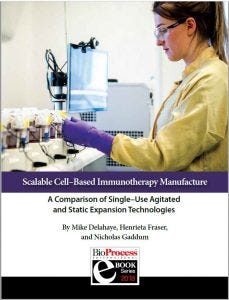eBook: Scalable Cell-Based Immunotherapy Manufacture: A Comparison of Single-Use Agitated and Static Expansion TechnologieseBook: Scalable Cell-Based Immunotherapy Manufacture: A Comparison of Single-Use Agitated and Static Expansion Technologies
 Early clinical results indicate that personalized autologous immunotherapies could revolutionize cancer treatment (1). However, challenges lie in the realization of cost-driven, scalable cell therapy (CT) manufacturing strategies (2) for generating sufficient therapies to treat a populace, thereby limiting their translation to public health (3). Primary challenges involve complex needle-to-needle logistics, complexities in closed processing, and high variability in starting cell materials that define the autologous nature of such therapies.
Early clinical results indicate that personalized autologous immunotherapies could revolutionize cancer treatment (1). However, challenges lie in the realization of cost-driven, scalable cell therapy (CT) manufacturing strategies (2) for generating sufficient therapies to treat a populace, thereby limiting their translation to public health (3). Primary challenges involve complex needle-to-needle logistics, complexities in closed processing, and high variability in starting cell materials that define the autologous nature of such therapies.
Despite barriers in industrial-scale manufacture, public health management already has engaged in preparing reimbursement strategies for autologous immunotherapies (4). Thus, policy makers are indicating a commitment to reducing the risks for commercial CT ventures. That further translates to opportunities for suppliers of automated cell processing systems as well as contract process development organizations to mobilize next-generation autologous therapy manufacturing. Central to those strategies is expansion of T-cells, which typically has relied on closed, static culture flasks or bags (2).
Biomanufacturers have used agitating stirred-tank reactors (STRs) for decades, and many researchers already have investigated STR application for cell growth and protein production (5). Applying the same technology to autologous immunotherapy manufacture will have important implications on the cost of goods (CoGs) and will lend to scale-out strategies through parallel manufacturing streams (6, 7). The rigid physical structure of STRs allows for fixation of different feed, sample, and harvest lines to automate fluid handling. And emerging applications of online and offline process analytical technologies (PATs) allow the use of available sample ports to access and measure culture state for agile processing schedules, thus responding to the inherent initial variability in the materials (8). More recent developments in single-use STR technologies are low in cost, and they can be tubewelded into place, thus offering opportunity for lower air-grade (C or D) manufacture (9).
A strategical aim at The Cell and Gene Therapy Catapult (CGT) is collaborative development of next-generation autologous manufacture strategies. This study evaluates the expansion potential of stirred-tank bioreactors for immunotherapy manufacture and compares that to current state-of-the-art static and wave-agitated cultures.
Just fill out this form to download the eBook.
You May Also Like





